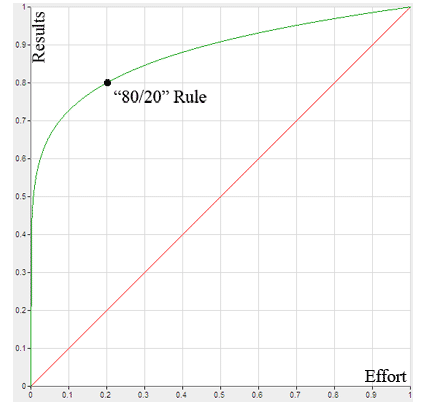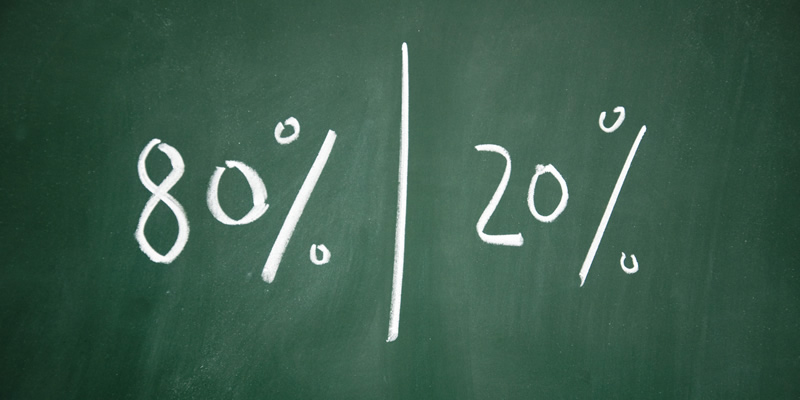In the very early 1900’s, an Italian economist by the name of Vilfredo Pareto created a mathematical formula describing the unequal distribution of wealth he observed and measured in his country: Pareto observed that roughly twenty percent of the people controlled or owned eighty percent of the wealth. In the 1940s, Dr. Joseph M. Juran, a Quality Management pioneer, attributed the 80/20 Rule to Pareto, calling it Pareto's Principle.
The key point is that most things in life (effort, reward, output) are not distributed evenly.
- 20% of the input creates 80% of the result
- 20% of the workers produce 80% of the result
- 20% of the customers create 80% of the revenue
- 20% of the tools in a toolbox are used in 80% of tasks
- 80% of your outcomes come from 20 percent of your inputs
- 80% of work absence is due to 20% of staff
- 80% of outcomes are from 20%of causes
- 80% of contribution comes from 20% of the potential contribution available
- and so on.
Also 80 percent of your sales will come from 20 percent of your sales staff. 20 percent of your staff will cause 80 percent of your problems, but another 20 percent of your staff will provide 80 percent of your production. It works both ways.
The Pareto Principle or 80/20 rule is an incredible powerful tool, however, the key is knowing how and when to apply it, and leveraging its exponential properties. Knowing this, if... 20% of workers contribute 80% of results: Focus on rewarding these employees. 20% of customers contribute 80% of revenue: Focus on satisfying these customers. The examples go on. The point is to realize that you can often focus your effort on the 20% that makes a difference, instead of the 80% that doesn’t add much. In economics terms, there is diminishing marginal benefit and this is related to the law of diminishing returns.
A simple clarification: the numbers in the ration do not have to add up to 100. For any particular situation the precise ratio can and probably will be different to 80:20, but the principle will apply nevertheless, and in many cases the actual ratio will not be far away from the 80:20 general rule.

Now while the Pareto Principle has been used since time ago, a recent and unique interpretation of the principle has taken its importance to a new level: the 80/20 Rule is exponential! This means that you can identify the 20% of the 20%. The 20% of the 20% of your subset – or the 4% – is producing 64% of your results. The 20% of the 20% is your optimal peak performance segment. Identify this segment and replicate it in any way possible. Find this 4% and foster it, replicate it, and nurture it, and you’ll find yourself producing explosive results in the long term.
Specifically in software engineering, there a corollary principle: "20 percent of the code has 80 percent of the errors. Find them, fix them!". In a next article we will develop how to apply the 80/20 Rule in Software Engineering. Stay tuned!

About Edgardo Gamboso
Edgardo is Creative Copywriter with more than 8 years of experience working for different kind of projects and for some of the most important brands as a project leader and creative director.
Nowadays Edgardo is responsible for managing all the communications within TISA Software. Beyond his marketing knowledge and his passion for the technology Edgardo enjoys seeing TV series and doing outdoor sports, mainly riding bike and running.













